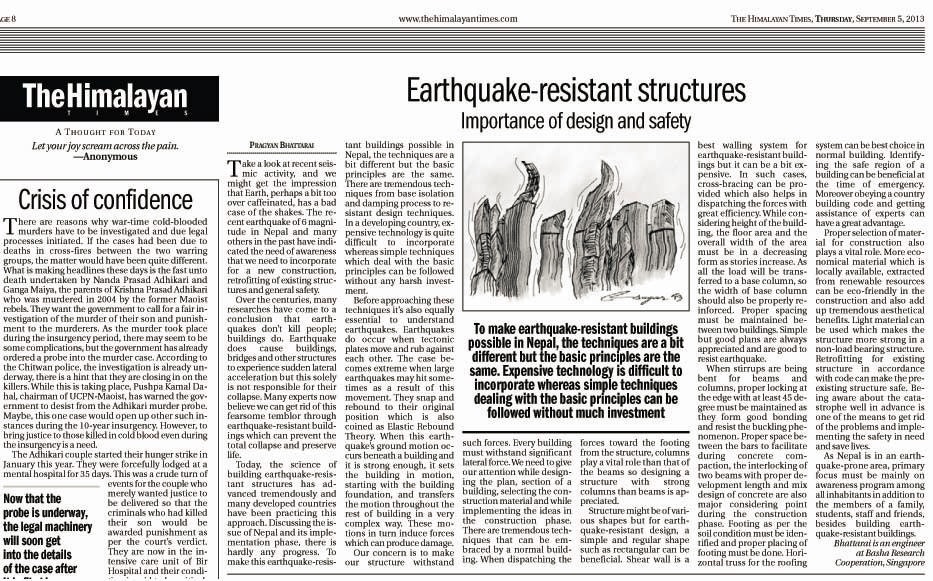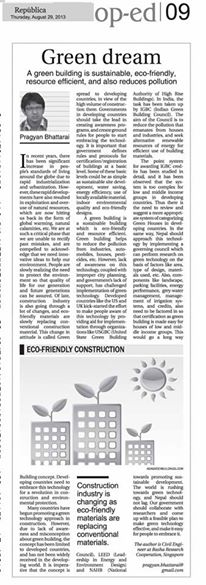Earthquake Resistant Design and Safety
To make a earthquake resistance design, a technique are bit different but the principal are same .
Recent seismic activity may give the impression that the Earth, perhaps overstimulated, is experiencing a case of persistent tremors. The recent 6.0 magnitude earthquake in Nepal, along with numerous previous quakes, underscores the urgent need for heightened awareness regarding new construction, retrofitting of existing structures, and general safety. Kathmandu, identified as one of the most seismically active zones, faces risks due to unplanned settlements, inadequate construction practices, and rapid population growth. Historically, we have suffered significant loss of life and property in the 20th century, and similar events could recur at any moment. The frequent seismic activity suggests a troubling future with a trembling, unstable crust.
Research over the centuries has consistently concluded that earthquakes themselves do not kill people; rather, it is the collapse of buildings that causes fatalities. While earthquakes induce sudden lateral acceleration in structures, the collapse is not solely due to the quake itself. Many experts now believe that earthquake-resistant buildings, designed to prevent total collapse and preserve lives, can mitigate this risk. The science of constructing earthquake-resistant structures has advanced significantly, with many developed countries adopting these practices. However, in Nepal, the implementation of such techniques has seen limited progress. While advanced methods such as base isolation and damping are effective, they may be cost-prohibitive for a developing country. Therefore, simpler techniques adhering to basic principles can be employed without substantial investment.
Understanding earthquakes is crucial before implementing these techniques. Earthquakes occur when tectonic plates move and rub against each other. When this movement is extreme, the plates can snap and rebound to their original positions, a phenomenon known as Elastic Rebound Theory. This ground motion can induce complex forces in buildings, starting from the foundation and spreading throughout the structure, potentially causing damage. To ensure that structures can withstand such forces, careful attention must be given to the building's design, materials, and construction practices. Columns, for example, are more crucial than beams in transferring forces to the footing; thus, designing stronger columns is preferable. Regular, simple shapes such as rectangles are beneficial for earthquake resistance. Soft stories, such as those used for parking, should be avoided, with separate parking structures or alternatives considered.
Shear walls are an effective system for earthquake-resistant buildings, though they can be costly. Cross bracing is a more affordable alternative that efficiently distributes forces. Building height and floor area should decrease with additional stories, and base columns should be reinforced appropriately. Proper spacing between buildings and setbacks are also essential to prevent collapse. Construction practices must ensure proper bending and locking of stirrups, adequate spacing between bars for concrete compaction, interlocking of beams, and appropriate mix design of concrete. Footings should be designed according to soil conditions, and horizontal trusses can be a good choice for roofing systems. Identifying safe regions within buildings can be beneficial during emergencies.
Material selection is also critical. Economical, locally available, and renewable materials can enhance both sustainability and aesthetics. Lightweight materials can strengthen non-load-bearing structures. Retrofitting existing buildings according to codes can improve safety. Being proactive about disaster preparedness is key to safety. Preserving food, first-aid supplies, and identifying safe locations within a building can save lives. During an earthquake, staying calm and moving to safe places such as doorways or under sturdy furniture can be crucial. Post-earthquake safety measures include avoiding hazards such as gas leaks, water sewage breaks, downed power lines, and structural fires. In a seismically active area like Nepal, spreading awareness and educating families, students, staff, and the community is essential for effective disaster preparedness and response.
Nepali Version
पृथ्वीको सिस्मिक गतिविधि र भूकम्प-रोधी संरचनाको आवश्यकता
हालको सिस्मिक गतिविधिले पृथ्वी, जसलाई सायद अत्यधिक उत्तेजित भनिन्छ, को लगातार थरिथरि अवस्थाको संकेत दिन सक्छ। नेपालमा हालैको ६.० म्याग्निच्युडको भूकम्प र यसअघि भएका अन्य धेरै भूकम्पहरूले नयाँ निर्माण, विद्यमान संरचनाको रेट्रोफिटिङ र सामान्य सुरक्षामा ध्यान दिनको आवश्यकता दर्शाउँछ। काठमाडौं विश्वका सबैभन्दा सक्रिय सिस्मिक जोनहरूमा सूचीकृत छ, जसको कारण अव्यवस्थित बस्ती, अनुपयुक्त भवन निर्माण अभ्यास र वार्षिक जनसंख्या वृद्धिमा छ। ऐतिहासिक रूपमा, २०औं शताब्दिमा हाम्रो ठूलो जनहानि र सम्पत्ति क्षति भएको थियो, र यो स्थिति कुनै पनि समय पुनः दोहोरिन सक्छ। यो लगातार भूकम्पको गतिविधिले एक समस्याग्रस्त भविष्यको सङ्केत गर्दछ, जहाँ पृथ्वीको क्रस्ट बारम्बार कम्पन गर्दैछ।
सदियौंदेखि गरिएको अनुसन्धानले प्रायः यो निष्कर्ष निकालेको छ कि भूकम्पहरूले मानिसहरूलाई मार्दैनन्; अपितु, भवनहरूको ढलानले जनहानि निम्त्याउँछ। भूकम्पहरूले भवनहरूलाई तीव्र पार्श्व वेग प्रदान गर्छन्, तर यो ढलानको मुख्य कारण मात्र होइन। आजकलका विशेषज्ञहरूले भूकम्प-प्रतिरोधात्मक भवनहरूको डिज़ाइन गर्न सकिन्छ जुन पूर्ण ढलान रोक्न र जीवनलाई सुरक्षित राख्न सक्षम छ भन्ने विश्वास गर्न थालेका छन्।
भूकम्प-प्रतिरोधात्मक संरचनाहरू निर्माण गर्ने विज्ञानले अत्यधिक प्रगति गरेको छ, र धेरै विकसित देशहरूले यी अभ्यासलाई अपनाएका छन्। तर, नेपालमा यस्तो प्रविधिको कार्यान्वयनमा सीमित प्रगति भएको छ। आधार अलगाव र ड्याम्पिंगजस्ता उन्नत विधिहरू प्रभावकारी छन्, तर विकासशील देशको लागि लागत-अत्यधिक हुन सक्छ। त्यसैले, साधारण प्रविधिहरू प्रयोग गरिन सकिन्छ जुन आधारभूत सिद्धान्तहरूलाई पालन गर्दै ठूलो लगानी बिना लागू गर्न सकिन्छ।
यी प्रविधिहरू लागू गर्नुअघि भूकम्पहरूको समझ महत्त्वपूर्ण छ। भूकम्प तब हुन्छ जब टेक्टोनिक प्लेटहरू सँगै हिल्ने र रगड्ने गर्दछन्। जब यो गति चरम हुन्छ, प्लेटहरूले स्न्याप गरेर आफ्नो मूल स्थितिमा फर्किन्छन्, जुन "इलास्टिक रिबाउन्ड थ्योरी" को नामले चिनिन्छ। यसले भवनहरूमा जटिल बलहरू उत्पादन गर्न सक्छ, जसले आधारबाट सुरु गरी सम्पूर्ण संरचनामा फैलन्छ र क्षति निम्त्याउन सक्छ।
यसैले, संरचनाहरूले यस्ता बलहरूलाई सामना गर्न सक्षम हुनुपर्छ। प्रत्येक भवनले महत्त्वपूर्ण पार्श्व बललाई सहन गर्नुपर्छ। भवनको योजना, खण्ड, निर्माण सामग्री चयन र निर्माणको समयमा विचार गर्नुपर्ने महत्वपूर्ण कुराहरू हुन्। स्तम्भहरूले बललाई आधारमा प्रसारण गर्न महत्त्वपूर्ण भूमिका खेल्छन्, त्यसैले बलियो स्तम्भहरू डिजाइन गर्नु प्राथमिकता हो। सरल र नियमित आकृतिहरू, जस्तै आयताकार, भूकम्प प्रतिरोधात्मक डिजाइनमा लाभकारी छन्। नरम स्टोरीज, जस्तै पार्किङका लागि प्रयोग गरिने, अनुकूल हुँदैन; पृथक पार्किङ संरचनाहरू वा वैकल्पिक उपायहरू विचार गर्न सकिन्छ।
शियर वालहरू भूकम्प-प्रतिरोधात्मक भवनहरूको लागि प्रभावकारी प्रणाली हुन्, यद्यपि महँगो हुन सक्छ। क्रस ब्रेसिङ एक सस्तो विकल्प हो जुन बलहरूलाई प्रभावकारी रूपमा वितरण गर्छ। भवनको उचाइ र तलाको क्षेत्रफलले थप पद्धतिहरूमा घटाउनुपर्छ, र आधार स्तम्भहरूलाई उचित रूपमा सुदृढ गर्नु आवश्यक छ। भवनहरू बीचको सही दूरी र सेटब्याक पनि महत्त्वपूर्ण छन्।
निर्माण अभ्यासले सही स्टिरपको वाक्ने र लकिङ्ग, कंक्रीटको संकुचनका लागि बारहरू बीचको उचित दूरी, बीमहरूको अन्तर-लकिङ्ग र कंक्रीटको मिक्स डिजाइन सुनिश्चित गर्नुपर्छ। माटोको स्थितिअनुसार फाउण्डेसन डिजाइन गर्नुपर्छ, र छानो प्रणालीको लागि क्षैतिज ट्रस उपयुक्त विकल्प हुन सक्छ। आपतकालीन अवस्थामा भवनको सुरक्षित क्षेत्र पहिचान गर्नु लाभकारी हुन सक्छ।
निर्माणको लागि सामग्रीको चयन पनि महत्वपूर्ण छ। आर्थिक, स्थानीय रूपमा उपलब्ध र नवीकरणीय स्रोतबाट प्राप्त सामग्रीहरू पर्यावरणमैत्री र सौंदर्य दृष्टिले फाइदाजनक छन्। हल्का सामग्रीहरूको प्रयोगले संरचनालाई बलियो बनाउँछ। विद्यमान संरचनाको रेट्रोफिटिङको लागि कोडको अनुसार सुधार गर्न सकिन्छ।
प्राकृतिक प्रकोपको पूर्व जानकारी हुनु समस्याबाट बच्नको एक तरिका हो। खाना, प्राथमिक उपचार सामग्री राख्नु र भवनभित्र सुरक्षित स्थानहरू पहिचान गर्नु जीवन बचाउन सक्दछ। भूकम्पको समयमा शान्त रहनु र सुरक्षित स्थानहरूमा जानु महत्वपूर्ण छ। भूकम्पपछि ग्याँस लिक, पानीको सिवेज ब्रेक, कम उचाइको तारहरू, र संरचनात्मक आगो र खतराहरू जस्ता खतराहरूबाट टाढा रहनु महत्त्वपूर्ण छ।
नेपाल जस्तो भूकम्प-प्रवण क्षेत्रमा, परिवार, विद्यार्थी, कर्मचारी र समुदायलाई जागरूक बनाउने कार्यक्रमहरू प्रभावकारी तयारी र प्रतिक्रिया सुनिश्चित गर्न महत्त्वपूर्ण छन्।
The Article is published in The himalayan times, Op-Ed Section, National paper of Nepal


